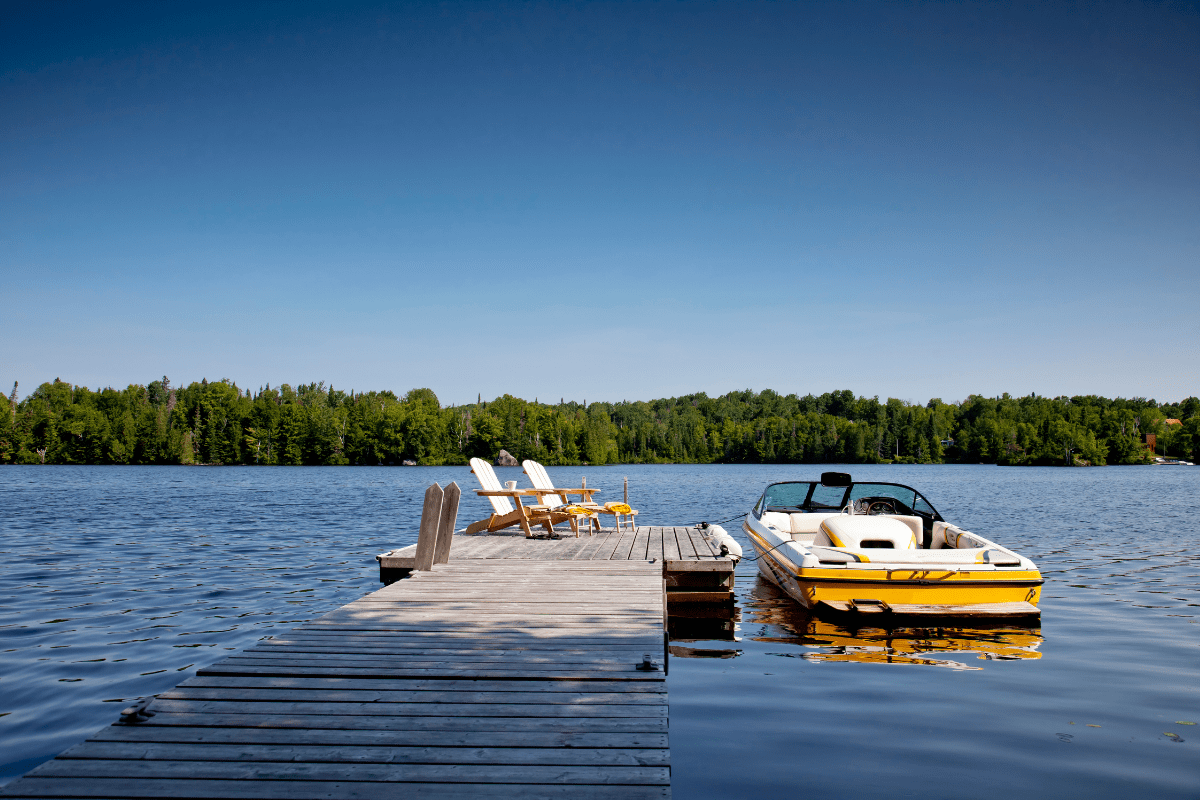Let's be honest: Michigan has so many fishing spots that choosing where to drop a line can feel like picking a Netflix show… overwhelming and slightly stressful. With 11,000 inland lakes, 36,000 miles of streams, and enough Great Lakes shoreline to reach from Detroit to Denver, you need insider knowledge to find the spots that actually produce fish, not just Instagram photos.
The Great Lakes: Where big fish make you question your reel's drag system
The stretch of Lake Michigan from Ludington to Frankfort is basically the Yankees of salmon fishing… consistently dominant and slightly intimidating to newcomers.
Lake Michigan's salmon highway
At Ludington's Pere Pointe Marina (yes, you can plug these coordinates into your phone: 43.963044, -86.452789), charter captains aren't just hoping for salmon, they're practically scheduling them. From July through September, King salmon averaging 10-16 pounds cruise these waters like underwater freight trains. The magic happens 100-150 feet down, where these chrome missiles hunt for alewives.
Here's what actually works when trolling for these beasts:
- Keep speed between 2.2-2.4 mph
- Dreamweaver spoons (the green ones work)
- Pro-Troll flasher/fly combinations
- Downriggers with 13-pound weights
- Patience (and maybe some Dramamine)
The best part? Ludington has 15 charter services, so even if you think "downrigger" sounds like a WWE move, you can still catch trophy salmon. Just don't be that person who brings bananas on the boat… seriously, captains hate that.
Manistee offers something special: Kings show up in late July, a full month before they hit most Michigan rivers. It's like having Black Friday deals in October. The combination of lake trolling in 140-220 foot depths and river fishing on the Big Manistee means you can literally fish year-round without repeating the same technique. March through May brings steelhead to the river system, while summer means lake trout are on the menu.
Lake St. Clair: The fish buffet
Lake St. Clair is what happens when Mother Nature decides to create the perfect multi-species fishery and actually nails it. At 430 square miles with an average depth of just 11 feet, this lake is basically a massive fish apartment complex where everyone gets along (until you put a hook in front of them).
The Detroit River spring walleye run in April is so reliable, you could set your calendar by it. Vertical jigging in 6-25 feet with 1/8 to 1/4 ounce jigs tipped with shiners produces limits with the consistency of a McDonald's drive-thru, except the walleye taste way better.
But the real stars here are the smallmouth bass. These bronze-backed brawlers average 3-4 pounds and fight like they're auditioning for an action movie. Trophy muskellunge over 30 pounds patrol the channels, turning grown adults into babbling children when they finally boat one. Winter brings jumbo perch through the ice, assuming you're brave enough to sit on a frozen lake in January (spoiler: thousands of Michiganders are).
The Superior and Huron options
Lake Superior around Munising and Marquette delivers year-round lake trout action with the personality of that reliable friend who always shows up. Shelter Bay, 18 miles west of Munising, gives you access to mid-lake shoals where trolling 120-150 feet deep regularly produces limits. You might also hook into coho, splake, or Atlantic salmon, because Superior likes to keep things interesting.
Lake Huron's Port Huron and Alpena areas are the Swiss Army knives of fishing spots. Thunder Bay near Alpena commonly produces four or more species per trip, which is either exciting variety or deeply confusing when you're trying to figure out what just hit your lure. The deep water close to shore at Port Huron means you can target both walleye and salmon without burning half your gas tank getting to the fishing grounds.
Inland lakes that won't require a second mortgage for gas
Michigan's inland lakes offer something the Great Lakes can't: the ability to fish productively without checking maritime weather forecasts or investing in commercial-grade rain gear.
Torch Lake: Clear water, unclear how you'll explain the gas receipts
Torch Lake's 19,000 acres of Caribbean-clear water make it Michigan's deepest inland lake at 285 feet. The north end near Grass River features weed beds so productive, even novice anglers look like pros. Spinnerbaits and soft plastics work magic here, especially in early morning when the bass are still groggy and making poor decisions.
The east side drop-offs from 20-50 feet hold suspended walleye and lake trout that actually bite, unlike your teenager when asked about their day. Multiple public launches mean you're never far from fishable water, though you might spend more time marveling at the crystal-clear depths than actually fishing.
Houghton Lake: Where even the fish are incentivized
As Michigan's largest inland lake at 22,000 acres, Houghton Lake doesn't mess around. The annual tagged fish contest with a potential $100,000 prize means you're literally fishing for lottery tickets with fins. The shallow, quickly warming waters make it perfect for families, assuming your family doesn't mind dad screaming "FISH ON!" at 6 AM.
The lake produces excellent catches of:
- Walleye (especially at night)
- Yellow perch (tasty table fare)
- Crappie (spring spawners)
- Bass (both flavors)
- Pike (toothy surprises)
Ice fishing from December through March transforms the lake into a small city of shanties, where grown adults sit in tiny houses staring at holes in the ice. It's weird, but it works.
The Inland Waterway: Burt and Mullett Lakes
These connected lakes in Cheboygan County are like fishing's version of a two-for-one deal. Burt Lake's 17,000 acres host excellent walleye populations, world-class smallmouth bass, and even muskellunge for those who enjoy emotional roller coasters.
Mullett Lake plays the mysterious sibling, producing larger walleye than Burt. The secret? Nighttime crawler harnesses in 40-foot depths around Round Point and the sunken islands. It's like the walleye hold secret meetings down there, plotting which angler to frustrate next.
Winter ice anglers find success fishing 18-24 feet for walleye and perch, assuming they can drill through ice that sometimes reaches "this might be excessive" thickness.
Hidden gems worth the GPS confusion
Fletcher Pond near Alpena is what happens when you dam a river in 1932 and accidentally create 9,000 acres of fishing paradise. The flooded timber creates so much structure, it's like fishing in a submerged forest… because that's literally what it is. Northern pike and largemouth bass thrive in this maze of stumps and cover.
The limited access for large boats means better fishing for those willing to navigate carefully. Jack's Landing Resort rents boats for $69 per day, which is cheaper than therapy and way more effective at reducing stress.
Lake Gogebic in the UP has produced more state angler awards than any other Upper Peninsula lake, which is like being valedictorian of fish school. Spring walleye cruise the rocky shorelines, summer patterns shift to weed beds in 8-15 feet, and winter produces jumbo perch that make the cold worthwhile.
Rivers that run through it (and by "it" we mean your chances of keeping dry)
Michigan's rivers offer something special: the chance to catch fish while standing in moving water pretending you know what you're doing.
The Au Sable: America's fly fishing classroom
The Holy Waters section from Burton's Landing to Wakeley Bridge is nine miles of flies-only, catch-and-release water that makes fly fishers weep with joy. Brown trout exceeding 20 inches lurk here, though they've seen every fly pattern known to humanity and probably have favorite comedians.
The famous Hexagenia limbata hatch creates summer evening fishing so good, it should be illegal (but thankfully isn't). The mainstream from Wakeley Bridge to Mio Pond offers trophy potential for those who can handle a drift boat without looking like they're attempting interpretive dance.
Pere Marquette: The steelhead highway
The Pere Marquette holds the distinction of being America's first river stocked with brown trout in 1884. Today, its 67 miles offer year-round steelhead opportunities with multiple distinct runs that overlap like a confusing Venn diagram of fish availability.
The flies-only section from M-37 to Gleason's Landing protects trophy brown trout that have graduate degrees in avoiding capture. The lower river near Baldwin provides excellent access for salmon and steelhead, assuming you can find parking during peak season (hint: arrive before dawn or bring a bicycle).
The Muskegon: Winter's heated fishing lane
Below Croton Dam, the Muskegon River creates 35 miles of tailwater that stays ice-free year-round. This 200-foot-wide river produces exceptional winter steelhead fishing from December through February, when most anglers are sitting inside complaining about the weather.
Urban options that don't require a passport
The Grand River through downtown Grand Rapids offers surprisingly good steelhead and salmon fishing. The 6th Street Dam area provides easy access, though you might have to explain to onlookers why you're wearing waders in the middle of the city.
The science of not getting skunked
Understanding when and how to fish in Michigan requires more strategy than just showing up with a rod and hope.
Seasonal intelligence gathering
Spring means walleye in the Detroit River, with April producing limits for those who understand vertical jigging. Summer creates thermoclines at 18-24 feet in inland lakes, concentrating fish like a underwater convention center. Fall triggers aggressive feeding in pike and muskie… October is basically their Thanksgiving, and you're serving dinner.
Weather matters more than your lucky hat. Barometric pressure between 29.8 and 30.2 creates optimal conditions. Rapidly falling pressure triggers feeding frenzies, while post-cold-front conditions require patience and possibly therapy.
Techniques that actually work (tested by people who catch fish)
Great Lakes trolling isn't just dragging lures around hoping for the best. You need:
- Downriggers (the expensive kind)
- Planer boards (the confusing kind)
- Line-counter reels (the precise kind)
- Multiple rods (the "honey, I swear I need another one" kind)
Speed matters: 2.0-2.7 mph for salmon and trout. Too slow and they ignore you. Too fast and they can't catch up. It's like dating, but with fish.
For river steelhead, 9-10 foot moderate action rods paired with 8-15 pound fluorocarbon leaders provide the perfect combination. Any heavier and you'll lose fish. Any lighter and you'll lose lures. And dignity.
The legal stuff (because jail orange clashes with camo)
Michigan requires fishing licenses for anyone 17 or older. Residents pay $26 annually, while non-residents fork over $76. The good news? No additional trout stamps needed. The bad news? You still need to follow the rules.
Lake sturgeon and muskellunge harvest requires registration within 24 hours, because the DNR likes to keep tabs on trophy fish. Special regulations protect spawning fish and maintain populations. The 50-inch minimum for muskellunge on Thornapple Lake ensures only true giants can be kept.
The Michigan DNR stocks over 9.7 million fish annually, including 2.4 million walleye fingerlings. Six state hatcheries work overtime to keep fishing quality high, though the fish seem unaware of this effort and remain stubbornly difficult to catch.
Local knowledge worth its weight in lead sinkers
The Michigan Charter Boat Association represents 600+ licensed captains operating from over 100 ports. Charter costs range from $400-800 for full-day trips, which sounds expensive until you calculate the cost of buying all that specialized equipment yourself.
Fishing clubs like the Grand Haven Steelheaders and Michigan Steelhead and Salmon Fishermen's Association offer valuable community resources. These aren't just groups of people arguing about lure colors (though that happens too). They provide education, conservation efforts, and most importantly, current fishing reports.
Local bait shops remain the Wikipedia of fishing intelligence. Places like Fletcher's Landing and shops around Houghton Lake offer not just tackle and bait, but current information on what's working, where fish are holding, and which patterns to avoid unless you enjoy disappointment.
The bottom line (not the fishing kind)
Michigan's fishing opportunities are like a buffet where everything actually tastes good. Whether you're trolling for salmon in the Great Lakes, casting for bass in crystal-clear Torch Lake, or standing knee-deep in a river trying to outsmart a steelhead, success comes from understanding the water, respecting the resource, and occasionally accepting that fish have bad days too.
The combination of extensive public access, science-based management, and sheer variety means you're never far from good fishing in Michigan. Just remember: the worst day fishing still beats the best day working, unless you're a professional angler, in which case you've won at life.





